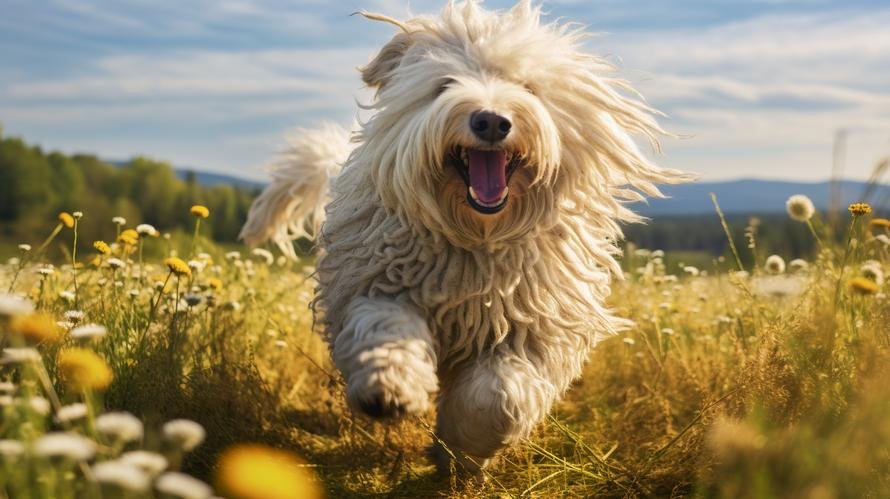Imagine a dog with a mop-like coat, making it look more like a walking household cleaning tool than a canine companion. The Komondor, often referred to as the “Mop Dog,” has one of the most unique appearances in the animal kingdom. Beyond its striking visual appeal, the Komondor is renowned for a demeanor that could be mistaken for the calm of a zen master. But what’s the reality behind this serene façade? Do they indeed embody tranquility, or is there more to their temperament than meets the eye?
Initially bred to guard livestock, the Komondor is ingrained with a natural protective instinct. These dogs aren’t just sitting around waiting for something to happen; they are vigilant observers, taking in every detail of their environment. This aspect of their character is a stark contrast to the almost meditative stillness they can project when at rest. However, owners and breed enthusiasts often sing praises of their composed nature at home—a trait not common in many guard dog breeds.
Their history is as thick and intertwined as their coat. Originating from Hungary, the Komondor’s ancestry traces back over a millennium. It is believed that they descended from Tibetan dogs and were brought to Hungary by the Cumans, a nomadic people. These dogs were bred to think independently and make decisions on their own to protect herds without direct supervision. Such breeding imparts a strong-willed and confident dog, characteristics that could potentially clash with the idea of a calm household pet.
It’s worth noting that their impressive corded coat is not merely for show—it’s a built-in armor designed to protect them from predators like wolves when they were standing guardians over their flocks. This fur requires significant maintenance, but unlike shedding breeds, the Komondor doesn’t leave a trail of hair behind. This hypoallergenic feature is another feather in their cap for those seeking a composed and tidy household.
Living with a Komondor means understanding their independent nature. They are sometimes perceived as aloof due to their tendency to observe rather than immediately engage. This demeanor comes from their days of solo work in the fields; they watch, assess, and then act only when necessary. It’s a stark contrast to the boundless exuberance often seen in breeds like the Labrador Retriever or Boxer.
Training a Komondor is an exercise in patience and respect. They do not respond well to heavy-handed methods; rather, they thrive with positive reinforcement and calm, authoritative guidance. The key is to earn their respect without breaking their autonomous spirit. Start training and socialization early, particularly because this ‘calm giant’ can grow to a substantial size—up to 100 pounds or more. Without proper training, their impressive stature and natural protective instincts can make them a handful.
In a family environment, Komondors can be as gentle as giants, displaying patience and a protective streak towards children. However, due to their size and strength, it’s always best to supervise interactions between any large breed and young children. When it comes to other pets, early socialization is critical. Their herding instincts can kick in, giving chase to smaller pets like cats, but with the right introduction, they can coexist peacefully.
Exercise for a Komondor isn’t about quantity; it’s about quality. They don’t have the endless energy reserves of, say, a Border Collie, but they do need regular exercise to keep them mentally and physically fit. Couple this routine with mental stimulation, like learning new commands or puzzle toys, to keep their sharp minds engaged.
Living accommodations for a Komondor can vary. While a home with ample outdoor space is ideal for their size, they can adapt to different living environments if their exercise needs are met. They may give off a calm appearance, lounging around the house, but they do have a vigorous side that needs to be expressed in active play and exploration sessions.
Regarding health, Komondors are generally a robust breed, but they’re not immune to genetic conditions typical of large breeds, such as hip dysplasia. Regular veterinary check-ups and a suitable diet will help ensure your Komondor remains the picture of health for many years.
For potential owners, the calm you might seek in a furry companion is certainly a part of the Komondor’s character, but it must be understood within the context of their heritage. Balancing their composed nature with their history as independent workers is the key to a happy and healthy relationship with these stunning dogs.
When considering if a Komondor is the right fit for your household, it’s critical to reflect on your ability to provide not just a loving home, but one that respects their need for mental engagement, physical activity, and clear, consistent guidance. Their calm demeanor is balanced by a strong-willed personality that requires a respectful, patient owner.
In conclusion, the Komondor can indeed be a calm dog, but this calmness is the fruit of a well-balanced diet of training, exercise, and social structure within the home. Owning a Komondor is embracing a piece of history, a dog breed that demands and deserves a full understanding of their complex nature. Those willing to invest the time and energy will find a loyal, loving, and yes, calm companion that provides an undeniable charm and uniqueness to any home.



